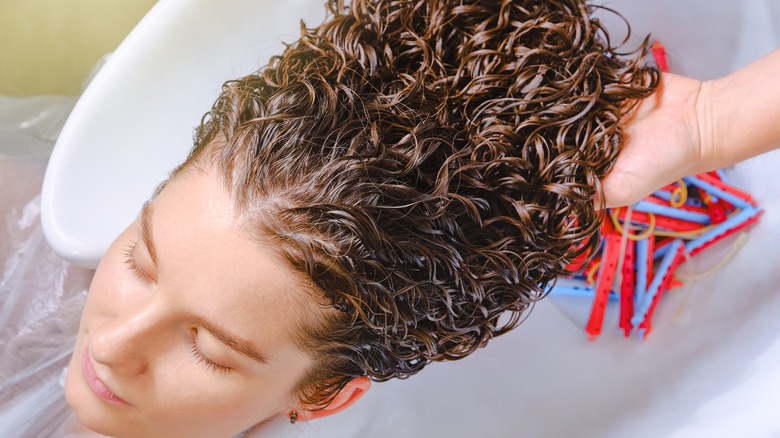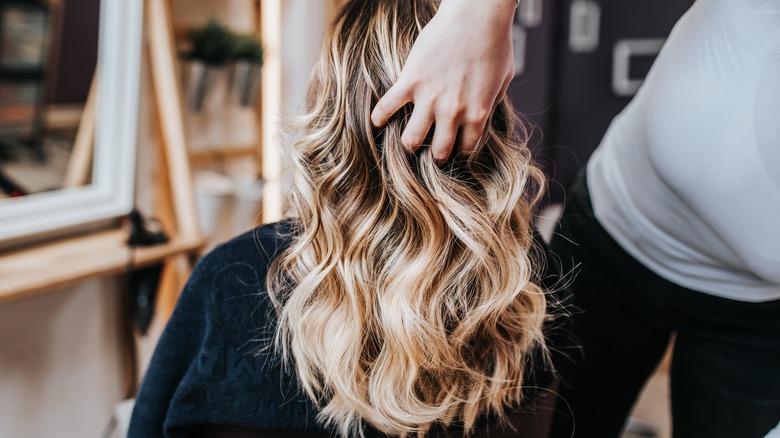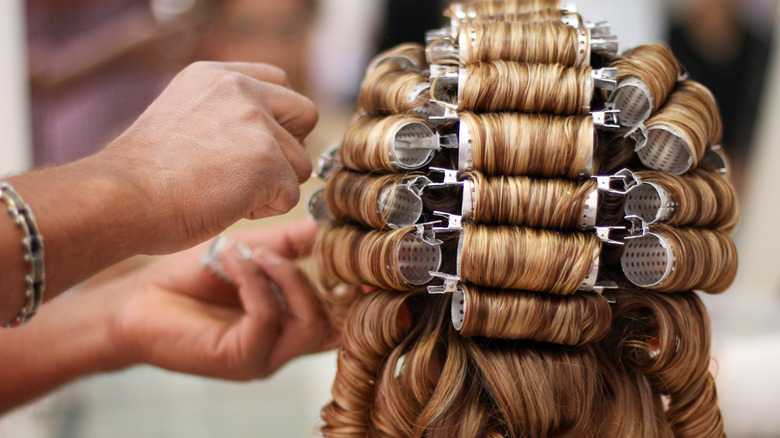Is It Ever Smart To Perm Color-Treated Hair? It's Complicated
For those who seek to give their mane an epic visual boost, hair dye or root perms are usually the go-to treatments. However, it's no secret that these hair styling methods can take a great toll on the hair. Color-treating your hair is one of the most surefire ways to weaken it. According to Walk-in Dermatology, ammonia and hydrogen peroxide, both of which are frequently found in hair coloring products, are capable of permuting the structure of the hair in a negative way. Hydrogen peroxide can damage your hair cuticle, while ammonia can irreversibly change your hair's pH level, leaving it drier, weaker, and more vulnerable to breakage. To keep your color-treated hair in tip-top shape, you'll have to put in the extra effort in your hair care routine, such as washing your hair less, air-drying it, and conditioning religiously.
Another hair treatment that puts your hair through a great deal of trauma is perming, a process that involves lots of heavy chemicals. Perms work by altering the structure of keratin, a protein that makes up about 95% of your hair, to give it a new shape. Although perms have evolved tremendously over the past decade, they still damage your hair over time.
Usually, people either get their hair dyed or get a hair perm, but it's not unusual to see people getting both nowadays. So, what happens if you perm color-treated hair? Is this combo a one-two punch for hair health?
You can perm color-treated hair, but should you?
According to hairstylist and hair colorist Erika in the Confession Of A Cosmetologist's advice column, although you can perm color-treated hair, it's not the best idea because putting your hair through multiple chemical processes can traumatize it down to the tiniest hair shaft. "You won't like how your hair feels, and you'll be so ready to get your pre-perm hair back," cautions Erika.
If you're still thinking about getting a perm after having had your hair color-treated, Erika recommends speaking to an experienced hairstylist first to discuss the best options for your hair needs. It is not recommended to attempt to DIY a perm on color-treated hair as you may end up in a situation like TikTok user @princess.raxhie, who damaged their hair so badly they had to shave it all off.
There actually are perm solutions that are softer and more suited for color-treated hair, although the high-quality ones can be on the expensive side and are typically only accessible through a distributor rather than an average hair salon, Erika points out. At the end of the day, only a hair expert can recommend the types of products that best suit your hair conditions and won't lead to irreversible damage.
If you must, perm first, then color
One way to potentially lessen damage is to perm your hair first to see how it reacts to chemicals. If it's in good condition after the treatment, you can proceed with a color service no sooner than two weeks later. Choose semi-permanent color because these dyes, in general, impart color to your hair sans abrasive chemicals so they are less likely to damage your hair than permanent dyes. Another reason why you should get a perm first is that perming freshly color-treated hair can cause the color to fade.
If your hair is not in good condition, hold your fire until the strands are healthy enough for the treatment. Also, you should never get a perm and a color service at the same time as the chemicals from both treatments would put excessive stress on your hair and make it more vulnerable to breakage and split ends.
By far, the healthiest option to add texture and color to your hair without compromising its health is to get a perm first, then obtain clip-in curly hair extensions with highlights that give your tresses brightness and lush fullness. This way, you can get both the hair color and texture of your choice. However, if you want styling options that can last you long term, it's best to consult an experienced hair stylist to find options that will bring the least damage to your hair.


